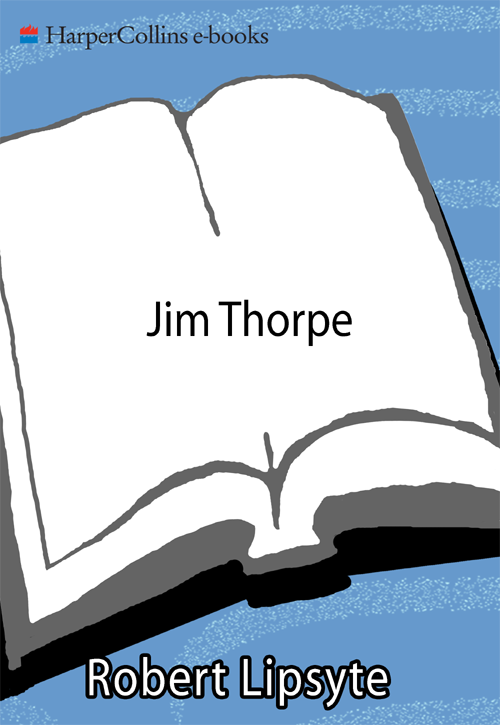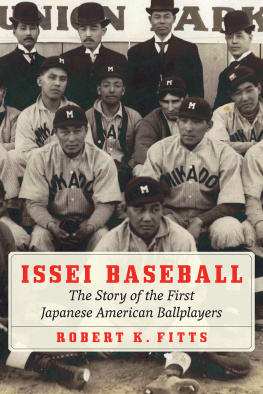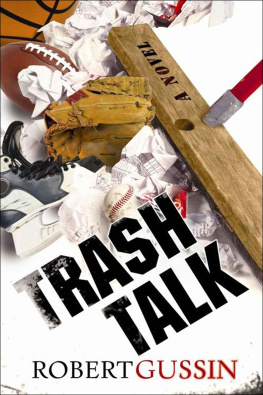Robert Lipsyte - Jim Thorpe: 20th-Century Jock
Here you can read online Robert Lipsyte - Jim Thorpe: 20th-Century Jock full text of the book (entire story) in english for free. Download pdf and epub, get meaning, cover and reviews about this ebook. year: 2011, publisher: HarperCollins, genre: Politics. Description of the work, (preface) as well as reviews are available. Best literature library LitArk.com created for fans of good reading and offers a wide selection of genres:
Romance novel
Science fiction
Adventure
Detective
Science
History
Home and family
Prose
Art
Politics
Computer
Non-fiction
Religion
Business
Children
Humor
Choose a favorite category and find really read worthwhile books. Enjoy immersion in the world of imagination, feel the emotions of the characters or learn something new for yourself, make an fascinating discovery.

- Book:Jim Thorpe: 20th-Century Jock
- Author:
- Publisher:HarperCollins
- Genre:
- Year:2011
- Rating:3 / 5
- Favourites:Add to favourites
- Your mark:
- 60
- 1
- 2
- 3
- 4
- 5
Jim Thorpe: 20th-Century Jock: summary, description and annotation
We offer to read an annotation, description, summary or preface (depends on what the author of the book "Jim Thorpe: 20th-Century Jock" wrote himself). If you haven't found the necessary information about the book — write in the comments, we will try to find it.
A biography of the American Indian known as one of the best all-round athletes in history for his accomplishments as an Olympic medal winner and as an outstanding professional football and baseball player.
Jim Thorpe: 20th-Century Jock — read online for free the complete book (whole text) full work
Below is the text of the book, divided by pages. System saving the place of the last page read, allows you to conveniently read the book "Jim Thorpe: 20th-Century Jock" online for free, without having to search again every time where you left off. Put a bookmark, and you can go to the page where you finished reading at any time.
Font size:
Interval:
Bookmark:
Young Adult Fiction
Center Field
Yellow Flag
Raiders Night
The Contender
The Brave
The Chief
Warrior Angel
One Fat Summer
Summer Rules
The Summerboy
The Chemo Kid
Jock and Jill
Young Adult Nonfiction
Jim Thorpe
Michael Jordan
Joe Louis
Arnold Schwarzenegger
Fiction
Liberty Two
Something Going (with Steve Cody)
Nonfiction
Nigger (with Dick Gregory)
The Masculine Mystique
Idols of the Game (with Peter Levine)
Assignment Sports
Free to Be Muhammad Ali
SportsWorld: An American Dreamland
Heroes of Baseball
In the Country of Illness: Comfort and Advice for the Journey
Memoir
An Accidental Sportswriter

SUPERSTAR LINEUP
JIM THORPE
20TH-CENTURY JOCK
ROBERT LIPSYTE

This page is for my team.
Robert Warren, my editor, and Theron Raines, my agent, were smart and steady coaches.
Kathy Sulkes, my wife, was the photo researcher who never quit.
Professor Peter Leuine of Michigan State Uniuersity checked the manuscript with his Captain History eye.
Benjamin Kabak, a student at the Horace MannBarnard School in New York, was a very helpful reader.
And without the editing, writing and research of Sam Lipsyte, there would be no pages after this one.
The first athletes of America were the Runners of the native Nations, the people who have come to be called Indians. These Runners were fast and dependable and smart. They memorized messages that might take hours to tell, and they remembered them for days at a time, while running through unfamiliar, sometimes hostile territory. Then, after delivering the long message, a Runner might even be expected to help negotiate a peace treaty, work out an alliance for war, offer advice in a sensitive political situation or take another long message back home.
The Runners were heroes, admired for their intelligence, their dedication and their athletic skills, which they kept at peak performance by regular training. It was a full-time job; they ran thousands of miles in preparation for their journeys, studied with their tribal wisdom keepers and ate vegetables, grains and the meat of swift creatures such as antelope and quail.
Sometimes they competed against each other in public races, betting clothes and jewelry. In their daily lives of exercise and careful nutrition and relaxation, of listening to older Runners and to the Chiefs, they were like modern athletes. Yet the importance of their duties made them similar to modern diplomats and journalists. They bound their world together with their savvy and their speed.
They ran the Iroquois Trail in what is now upstate New York. They found ways to ford the swollen spring rivers of the Midwest, and they made their own paths through dense southern forest. They clawed up the sheer rock cliffs of the Pacific Coast.
In 1680, in the cool of the Southwest night, pairs of Pueblo Indian Runners coursed over the high desert in what is now northern New Mexico, carrying messages coded into carved sticks and knotted strings. Their mission was to signal the Pueblo Indians to rise up against the Spanish colonists who had taken control of their villages, burned their sacred masks and flogged their religious leaders. For the Runners, discovery meant instant death. But timidity was worse; if they were late, if the attack wasnt precisely coordinated, the revolt would fail and thousands of Indians would be killed. The Runners were successful, and so was the Pueblo uprising; it was an American revolution a century before the American Revolution.
Sometimes Indian Runners carried heroic messages, and sometimes they tried to stop foolish slaughter. In 1790, the Creeks and the Choctaws, in an attempt to decide who had the rights to trap beaver on a pond of the Noxubee River in Mississippi, played winner-take-all bump hips, the game that became lacrosse. As the game was often played in those days, there were hundreds to a side, and the goals were miles apart. The brawling contest soon became a bloody riot; hundreds might have died except for the speed of couriers who brought the head Chiefs to settle the dispute.
In 1890, Runners made their way to Washington, D.C., to tell the Indian version of the massacre at Wounded Knee. More than a hundred Indians, including many women and children, were killed at the Pine Ridge Reservation in South Dakota when U.S. cavalry troopers began firing into the spiritual gathering called Ghost Dancing.
Indian athletes competed against whites, and because Indians had been hyped by newspaper reporters and cavalrymen as such powerful savages, it was big news when a white athlete beat an Indian. In 1844, in Hoboken, New Jersey, 30,000 whites cheered the New York carpenter who beat John Steeprock, a Seneca, in a $$ 1,000 long-distance run. The sportswriter who covered the story declared the victory a triumph of white superiority.
Tom Longboat, an Onondaga (known as The Bronze Mercury when he won the 1907 Boston Marathon), and Louis Tewanima, a Hopi, ran in the 1908 Olympics. Ellison (Tarzan) Brown won the Boston in 1936, and then went on to the Berlin Olympics as a member of the U.S. team. In 1964, Billy Mills, an Oglala Sioux, became the first American to win the 10,000-meter Olympic championship. There were fine major-league baseball players as Louis Sockalexis (it is said that the Cleveland Indians were named after him); Charles Bender, who was elected to the Hall of Fame; John Meyers; and Allie Reynolds.
But the most famous Indian athlete, and perhaps the greatest all-around male athlete in American history, was more than a sporting hero, and his victories were more than marks in a record book.
Jim Thorpe was a spirit of his time, a symbol of a country flexing its muscles in the world arena, a person who would not be beaten down; he was an athletic pioneer, but he also followed a path blazed by centuries of Runners for the Nation. The message he carried was his own story.
An Indian who is as bad
as a white man could not
live in our Nation.
B LACK H AWK
The graceful, restless boy Bright Path had hair as black and glistening as a ravens wing. His eyes were merry and bold. His jutting chin was square and strong. The old people watched him roam the reservation and reminded each other that this boy carried the blood of Black Hawk, their legendary warrior chief. The boy was half white, and his parents, the Thorpes, called him Jim more often than they called him Bright Path. But the old people filled the boys head with tales of his great-uncle, who had led them against United States soldiers in the most painful, the proudest time in their history.
The Black Hawk War was short and bloody, a disaster for the Sac and Fox Nation. The natives lost the land they farmed and hunted along the Mississippi River in what is now Illinois and Iowa.
The war began in 1832 after some members of the Nation sold land to the white American government without permission of the Sac and Fox council, which had ruled that land was not an individuals to sellall the land belonged to all the people together. There were reports that the sellers had been bribed with whiskey.
Next pageFont size:
Interval:
Bookmark:
Similar books «Jim Thorpe: 20th-Century Jock»
Look at similar books to Jim Thorpe: 20th-Century Jock. We have selected literature similar in name and meaning in the hope of providing readers with more options to find new, interesting, not yet read works.
Discussion, reviews of the book Jim Thorpe: 20th-Century Jock and just readers' own opinions. Leave your comments, write what you think about the work, its meaning or the main characters. Specify what exactly you liked and what you didn't like, and why you think so.





